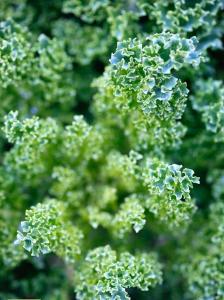Brassica oleracea var. acephala
(Blue Curled Kale)
100 Seeds
Brassica oleracea (otherwise known as wild cabbage or wild mustard) is an incredibly diverse assemblage of edible plants that, while they appear to be different species, are in fact cultivars of the same species. It is native to southern and western Europe. It grew primarily in coastal areas as it has high salt and lime tolerance. It was not a very good competitor in open prairies and thus, was restricted naturally to limestone sea cliffs.
Kale is very high in beta carotene, vitamin K, vitamin C, lutein, zeaxanthin, and reasonably rich in calcium. Kale, as with broccoli and other brassicas, containssulforaphane (particularly when chopped or minced), a chemical believed to have potent anti-cancer properties.[citation needed] Boiling decreases the level of sulforaphane; however, steaming, microwaving, or stir frying do not result in significant loss.[1] Along with other brassica vegetables, kale is also a source of indole-3-carbinol, a chemical which boosts DNA repair in cells and appears to block the growth of cancer cells.[2][3]Kale is also a good source of carotenoids.[4]
[edit]
Growing Instructions:
Kale is a cool-weather crop that requires two months of cool weather to reach harvest. Sow seeds indoors or outdoors 4 to 6 weeks before the last frost in spring or as soon as the soil can be worked. Kale is commonly started indoors and transplanted into the garden when seedlings are 4 to 6 weeks old
(Blue Curled Kale)
100 Seeds
Brassica oleracea (otherwise known as wild cabbage or wild mustard) is an incredibly diverse assemblage of edible plants that, while they appear to be different species, are in fact cultivars of the same species. It is native to southern and western Europe. It grew primarily in coastal areas as it has high salt and lime tolerance. It was not a very good competitor in open prairies and thus, was restricted naturally to limestone sea cliffs.
Kale is very high in beta carotene, vitamin K, vitamin C, lutein, zeaxanthin, and reasonably rich in calcium. Kale, as with broccoli and other brassicas, containssulforaphane (particularly when chopped or minced), a chemical believed to have potent anti-cancer properties.[citation needed] Boiling decreases the level of sulforaphane; however, steaming, microwaving, or stir frying do not result in significant loss.[1] Along with other brassica vegetables, kale is also a source of indole-3-carbinol, a chemical which boosts DNA repair in cells and appears to block the growth of cancer cells.[2][3]Kale is also a good source of carotenoids.[4]
[edit]
Growing Instructions:
Kale is a cool-weather crop that requires two months of cool weather to reach harvest. Sow seeds indoors or outdoors 4 to 6 weeks before the last frost in spring or as soon as the soil can be worked. Kale is commonly started indoors and transplanted into the garden when seedlings are 4 to 6 weeks old
- Brand WSF
00700
Payment Methods


Shipping
FREE Shipping
Shipping Policy
Item is shipped out within 3 business days.
Return/Exchange Policy
Exchanges are accepted but not returns.
Please Login or Register first before asking a question.


































